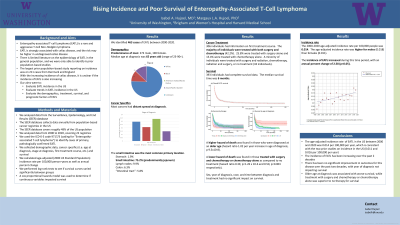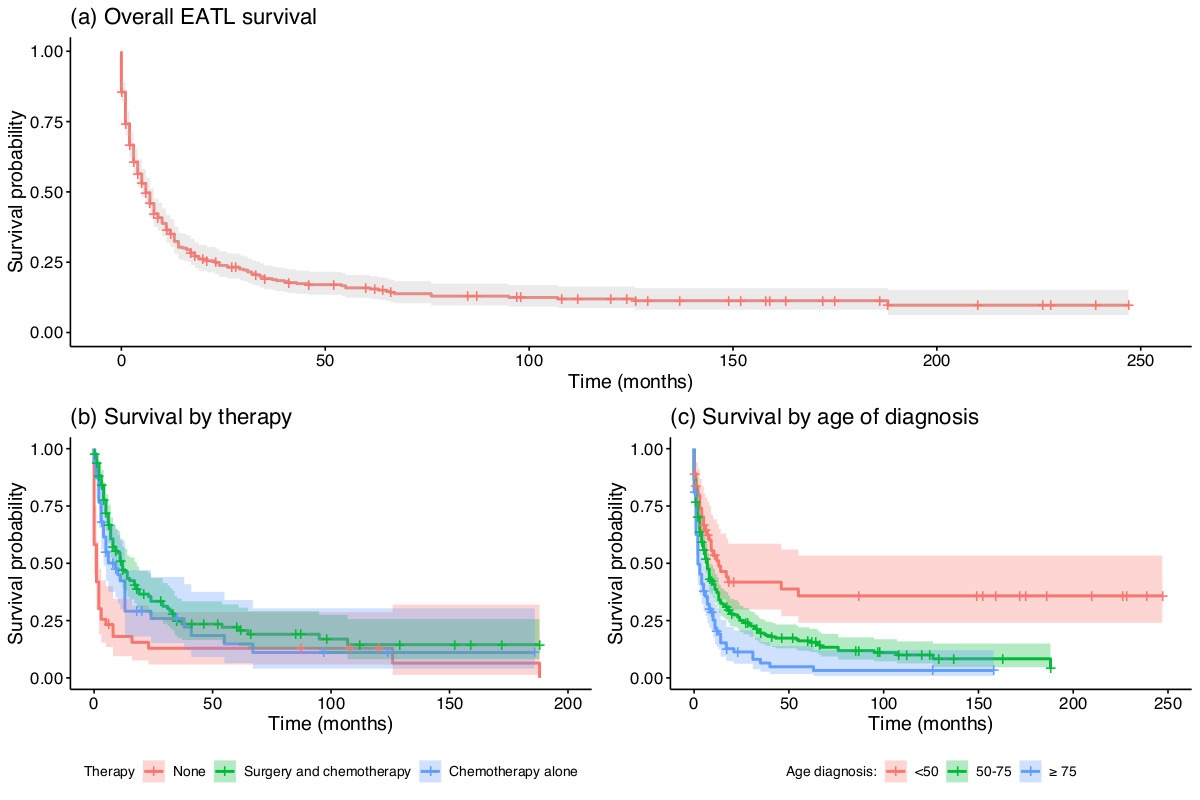Sunday Poster Session
Category: Small Intestine
P1249 - Rising Incidence and Poor Survival of Enteropathy-Associated T-Cell Lymphoma
Sunday, October 22, 2023
3:30 PM - 7:00 PM PT
Location: Exhibit Hall

Has Audio
- IH
Isabel A. Hujoel, MD
University of Washington
Seattle, WA
Presenting Author(s)
Award: Outstanding Research Award in the Small Intestine Category
Award: Presidential Poster Award
Isabel A.. Hujoel, MD1, Margaux Hujoel, PhD2
1University of Washington, Seattle, WA; 2Broad Institute, Boston, MA
Introduction: Enteropathy-associated T-cell Lymphoma (EATL) is associated with celiac disease. There is limited recent data available on EATL, and with the rise in prevalence of celiac disease, it is unclear if EATL is similarly increasing.
Methods: We utilized the Surveillance, Epidemiology, and End Results (SEER) database, a United States (US) cancer surveillance program from 22 geographic regions, covering 47.9% of the total US population. Cases of EATL diagnosed between 2000-2020 were identified by ICD-O3 code 9717/3. Incidence rates were calculated using the SEER*Stat software. Annual percent change (APC) was calculated using the Joinpoint software. We performed log-rank tests to see if survival curves between groups were significantly different and used Cox proportional hazards model to determine if continuous variables impacted survival.
Results: 463 cases of EATL were identified (273 male, 190 female), with a median age of 65 (range 23-90+). 350 individuals were white, 53 black, 1 American Indian/Alaska Native, 58 Asian or Pacific Islander, and 1 unknown ethnicity. The majority of cases (257; 55.5%) had metastases at diagnosis, while 29.3% had localized disease. The 2000-2020 age-adjusted incidence rate per 100,000 people was 0.014. The incidence of EATL increased from 2000 to 2020, with an APC of 2.58 (p< 0.05). Of the 306 individuals with information on treatment, the majority (129, 42.2%) were treated with surgery and chemotherapy. 79(25.8%) were treated only with surgery and 47 (15.4%) with chemotherapy alone. The rest received either surgery and radiation(2), chemotherapy, radiation, and surgery(6), or no treatment(43). Median survival time was 6 months. Of the 393 with complete survival data, we found that individuals diagnosed at a later age had a significantly higher hazard of death (hazard ratio (HR)1.02 per year increase in age of diagnosis, p=9.5x10-8). Individuals who receive surgery and chemotherapy, or chemotherapy alone, have a significantly lower hazard of death than individuals who receive no treatment (HR = 0.39, p=1.26 x 10-6 and 0.50, p=0.00285 respectively). Sex, year of diagnosis, race, and time between diagnosis and treatment had no significant impact on survival.
Discussion: We found a significant increase in the incidence of EATL in the US between 2000-2020. Survival is dismal, with no improvement in mortality over the past 2 decades. A combination of surgery and chemotherapy was the predominant mode of therapy.

Disclosures:
Isabel A.. Hujoel, MD1, Margaux Hujoel, PhD2. P1249 - Rising Incidence and Poor Survival of Enteropathy-Associated T-Cell Lymphoma, ACG 2023 Annual Scientific Meeting Abstracts. Vancouver, BC, Canada: American College of Gastroenterology.
Award: Presidential Poster Award
Isabel A.. Hujoel, MD1, Margaux Hujoel, PhD2
1University of Washington, Seattle, WA; 2Broad Institute, Boston, MA
Introduction: Enteropathy-associated T-cell Lymphoma (EATL) is associated with celiac disease. There is limited recent data available on EATL, and with the rise in prevalence of celiac disease, it is unclear if EATL is similarly increasing.
Methods: We utilized the Surveillance, Epidemiology, and End Results (SEER) database, a United States (US) cancer surveillance program from 22 geographic regions, covering 47.9% of the total US population. Cases of EATL diagnosed between 2000-2020 were identified by ICD-O3 code 9717/3. Incidence rates were calculated using the SEER*Stat software. Annual percent change (APC) was calculated using the Joinpoint software. We performed log-rank tests to see if survival curves between groups were significantly different and used Cox proportional hazards model to determine if continuous variables impacted survival.
Results: 463 cases of EATL were identified (273 male, 190 female), with a median age of 65 (range 23-90+). 350 individuals were white, 53 black, 1 American Indian/Alaska Native, 58 Asian or Pacific Islander, and 1 unknown ethnicity. The majority of cases (257; 55.5%) had metastases at diagnosis, while 29.3% had localized disease. The 2000-2020 age-adjusted incidence rate per 100,000 people was 0.014. The incidence of EATL increased from 2000 to 2020, with an APC of 2.58 (p< 0.05). Of the 306 individuals with information on treatment, the majority (129, 42.2%) were treated with surgery and chemotherapy. 79(25.8%) were treated only with surgery and 47 (15.4%) with chemotherapy alone. The rest received either surgery and radiation(2), chemotherapy, radiation, and surgery(6), or no treatment(43). Median survival time was 6 months. Of the 393 with complete survival data, we found that individuals diagnosed at a later age had a significantly higher hazard of death (hazard ratio (HR)1.02 per year increase in age of diagnosis, p=9.5x10-8). Individuals who receive surgery and chemotherapy, or chemotherapy alone, have a significantly lower hazard of death than individuals who receive no treatment (HR = 0.39, p=1.26 x 10-6 and 0.50, p=0.00285 respectively). Sex, year of diagnosis, race, and time between diagnosis and treatment had no significant impact on survival.
Discussion: We found a significant increase in the incidence of EATL in the US between 2000-2020. Survival is dismal, with no improvement in mortality over the past 2 decades. A combination of surgery and chemotherapy was the predominant mode of therapy.

Figure: Survival in Enteropathy-associated T-cell Lymphoma (2000-2020).
Disclosures:
Isabel Hujoel indicated no relevant financial relationships.
Margaux Hujoel indicated no relevant financial relationships.
Isabel A.. Hujoel, MD1, Margaux Hujoel, PhD2. P1249 - Rising Incidence and Poor Survival of Enteropathy-Associated T-Cell Lymphoma, ACG 2023 Annual Scientific Meeting Abstracts. Vancouver, BC, Canada: American College of Gastroenterology.


